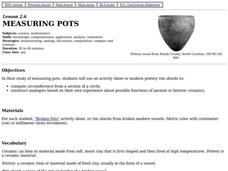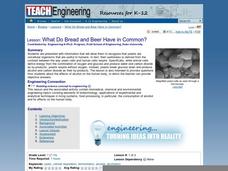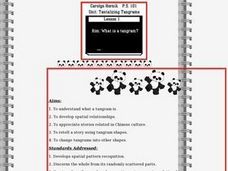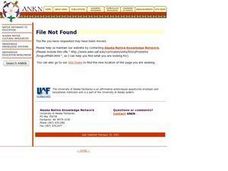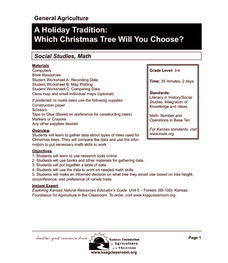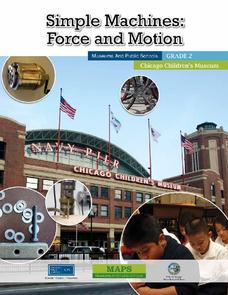Curated OER
Geometry of Democracy
Learners explore the architecture of New England by identifying geometric shapes. In this architectural lesson, students examine photographs of classic building architecture and use a transparency to trace geometric shapes they...
Texas Commission on the Arts
The Quarter Fold
Little ones identify the US quarter and explore the concept of one-fourth or one-quarter. Using real coins or coin manipulatives, they divide a square piece of paper into quarters, discuss halves and quarters, and create a design that...
Curated OER
Mathematics at the Frontier of Astronomy
Students explore the different types of measurements used in astronomy. In this space science lesson plan, students explain the relationship between planets' orbits and distance from the sun using Kepler's Laws. They discuss how math...
Curated OER
Human Abstraction
Students explore and compare abstraction of human forms in various ancient cultures and by creating self-portraits using geometric shapes. They identify which geometric shapes form the following features: face, nose, arms, torso, legs,...
Curated OER
Measuring Pots
Students use an activity sheet to construct analogies about possible function of ancient or historic ceramics and compute circumference from a section of a circle as they study measuring pots.
Curated OER
What Do Bread and Beer Have in Common?
Students listen to an explanation of yeast cells and how they effect bread and beer. They discuss the ways alcohol affects the human body and participate in an indirect observation about cell respiration in yeast-molasses cultures.
Curated OER
What is a Tangram?
Students identify a tangram. In this geometry lesson, students read Grandfather Tang's Story and retell each story using the tangrams on a flannel board. Students use tangrams to complete an included worksheet.
Curated OER
You Are What You Eat (Grades 5-8)
Students gain an enhanced understanding of the relationship between proper nutrition and good health. Through use of video, hands-on activities and interaction, students measure energy in food, and recognize sources of vitamins and...
Curated OER
Lost Treasures of Tibet: Mandalas
Students examine the history of mandalas from Tibet. After reviewing the Designing a Mandala handout, they use geometric symmetrical shapes to create their own examples. Next, they write poems or essays and explain the meaning of the...
Curated OER
Proving the Pythagorean Theorem
Young scholars solve problems using the pythagorean Theorem. In this geometry lesson, students complete proofs using the Pythagorean Theorem. They share their proofs and solutions with their classmates and family members.
Curated OER
Do You Have a Sinking Feeling
Students determine how marine archaeologists use historical and archaeological data to draw inferences about shipwrecks. Students plot the position of a shipwrecked vessel, and draw inferences about the shipwreck from artifacts that have...
Curated OER
Factoring With Polynomials
In this algebra worksheet, students factor polynomials using the greatest common factor. They also use the foil method. There are 8 questions with an answer key.
Curated OER
US Geography, The Blues
This lesson enables teachers to use blues styles and performers to think about various geographical regions of the United States. By studying different blues styles from the Mississippi Delta, Texas, and the Piedmont region of the...
Curated OER
High School Mathematics Problems from Alaska: Dog Lot Math
Students determine the cost of feeding dogs during the winter and summer months when using commercially produced dog food.
Curated OER
Dog Lot Math
Students use their problem-solving skills to answer math problems. They determine the cost of feeding sled dogs. They share their answers with the class.
Agriculture in the Classroom
A Holiday Tradition: Which Christmas Tree Will You Choose?
Different varieties of Christmas trees provide an interesting way to combine social studies, science, math, and technology. Class members not only research the history of the Christmas tree holiday tradition, they compare and...
Curated OER
Maya Math: From Zero to Nineteen
Students explore counting methods of the ancient Maya, and practice identifying Maya number glyphs.
Curated OER
Math Quilts
Students examine geometric shapes. In this geometric shape lesson plan, students examine how geometric shapes flip, turn, and slide to create a pattern. Students analyze the role that quilts played in helping slaves escape to freedom. ...
Curated OER
Math: Perimeter, Area, and Volume
Eighth graders discover how to compute the perimeter, area, and volume of different objects. With partners, they find and calculate the perimeter , area, and volume of 10 items each and exchange information. Students compile their...
Curated OER
Math-- "What Is the Day Today?"--Measurements of Time
In this measurement of time learning exercise, students read a one page information text about measuring time and the origin of the calendar. Students answer 20 questions in which the days and months are listed in order.
Curated OER
What Is Kwanzaa?
Students use vocabulary related to Kwanzaa. They identify main ideas and details related to the celebration of Kwanzaa and summarize information about Kwanzaa. They make picture books appropriate for first and second graders.
Curated OER
Creating a Web Cookbook
Students use software to write a menu, including suggestions based on their own experiences cooking them, cultural and social context for their recipes and pictures or graphics. They shop for and cook the dinner for their families.
Curated OER
Come Tool Along With Me
Students create metallic Bas-relief scultures using basic art supplies and the technique of "tooling" in this Art lesson with croos-curricular connections in Social Studies and Math. A scoring rubric is included for assessment and...
Chicago Children's Museum
Simple Machines: Force and Motion
Get things moving with this elementary science unit on simple machines. Through a series of nine lessons including teacher demonstrations, hands-on activities, and science experiments, young scientists learn about forces, motion,...




